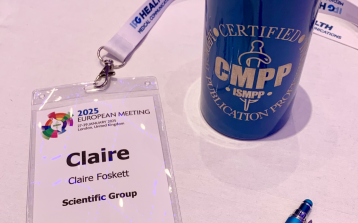Curiosity is a core company value at Scientific Group. Recently, one of our Principal Medical Writers was curious about chirality, and we encouraged them to dive deeper and spend some time researching the topic. We’re excited to share their insights – enjoy the read!
Life is built upon the principle of chirality, the property of asymmetry where molecules, much like left and right hands, cannot be superimposed on their mirror images.1,2 Living organisms almost always use one specific form of these chiral molecules: nearly all amino acids are left-handed, while DNA forms a right-handed double helix. Pairs of molecules that are non-superimposable mirror images are known as enantiomers.2 This preference for specific chirality is a cornerstone of biological function.
The (R)-enantiomer of carvone has the flavour and aroma of mint while the (S)-enantiomer of carvone is a component of caraway seeds.3 The (S)-enantiomer of ibuprofen is 100 times more active than the (R) form, which may cause side effects or toxicity.4
Omeprazole, the first proton pump inhibitor, is used to treat gastrointestinal conditions such as Helicobacter pylori and gastro-oesphageal reflux disease. It was originally introduced in 1989 and was then marketed 11 years later in its S-enantiomer form, esomeprazole, on the basis that this form would result in less interindividual pharmacokinetic variation.5
One notable example of the importance of chirality is thalidomide. The (S)-enantiomer is associated with teratogenic side effects, while the (R)-enantiomer serves as a mild sedative.2 This demonstrates the critical role of stereochemistry in molecular interactions. Notably, natural enzymes generally do not recognize mirror molecules, making the development of these compounds an intriguing avenue of scientific exploration.2
Potential applications of mirror molecules
The development of mirror molecules holds promise. Their resistance to biological degradation and the reduced likelihood of provoking immune responses make them valuable in various applications.2 For example, they can aid in determining protein structures through techniques like X-ray crystallography.2 Additionally, mirror molecules could lead to breakthroughs in therapeutic development and biotechnological innovation.
Although creating life from chemical building blocks remains a challenge, advancements in this field suggest it could be viable within the next decade. This progress raises the possibility of generating mirror organisms as a natural extension of such research.2 These mirror organisms could provide profound insights into the fundamental nature of life and the development of new therapies. However, as highlighted in a December 2024 Science article and an accompanying 299-page technical report,2,6,7 this research also comes with significant risks.
Risks of mirror bacteria
The Science technical report proposes that mirror bacteria, if created, would present unique challenges due to their potential resistance to immunological mechanisms. These organisms could evade detection by the innate immune system and other defenses, such as phagocytosis and the complement system.2 Furthermore, mirror proteins would resist degradation, impairing the activation of antibody production. Conventional antibiotics, which rely on the stereochemistry of their microbial targets, would likely be ineffective against these bacteria.2
Other natural control mechanisms, such as bacteriophages, would also struggle to interact with mirror receptors or replicate genomes. Protists and other predators might find it difficult to recognize or consume mirror bacteria, leaving these organisms unchecked in the environment. This immune evasion extends beyond humans to other animals, invertebrates, and plants, making ecosystems vulnerable to widespread disruption.2 Plant defenses, for instance, rely on several mechanisms that would be ineffective against mirror bacteria. These include:2
- Chiral receptors that detect generic microbial- or pathogen-associated molecular patterns
- Intracellular immune receptors, which detect pathogen virulence factors that suppress plant defenses or promote pathogen nutrition. These factors are unlikely to be found in mirror bacteria
- Small molecules, antimicrobial peptides, and proteases, which are mostly chiral in nature
Mitigation measures
The technical report outlines potential measures to mitigate some of the possible risks associated with mirror bacteria. However, it acknowledges significant uncertainty regarding the effectiveness, scalability, and timely implementation of these interventions.2 Even if harm to humans could be avoided, the ecological impact is likely to be catastrophic. Potential consequences include species extinction, habitat disruption, and the destabilization of geochemical cycles.2
Ethical and ecological considerations
While mirror bacteria remain theoretical, the 2024 Science article and accompanying report emphasize the importance of proactive discussions to minimize risks.2-4 These discussions must address the ethical implications of creating organisms that could evade natural controls and disrupt ecosystems. Scientists, policymakers, and stakeholders must work together to balance the potential benefits of this groundbreaking research with the responsibility to protect life as we know it.
Conclusion
The exploration of mirror molecules offers exciting possibilities for scientific advancement. However, the potential creation of mirror bacteria, requires careful consideration of the associated risks. It is imperative that progress is guided by ethical principles and a commitment to safeguarding against potential risks.
References
- Chirality. www.sciencedirect.com/topics/materials-science/chirality (Accessed 14 January 2025).
- Adamala KP, Agashe D, Binder DJ, et al. Technical report on mirror bacteria: Feasibility and risks. 2024. stacks.stanford.edu (Accessed 14 January 2025).
- American Chemical Society. Molecule of the Week Archive: Carvone. www.acs.org/molecule-of-the-week (Accessed 14 February 2025).
- Long WS, Know PC, Kamaruddin AH, Bhatia S. Comparison of kinetic resolution between two racemic ibuprofen esters in an enzymic membrane reactor. Process Biochem. 2005;40(7):2417–25,
- McVicker RU, O’Boyle NM. Chirality of new drug approvals (2013-2022): Trends and perspectives. J Med Chem. 2024;67(4):2305–20.
- Adamala KP, Agashe D, Belkaid Y, et al. Confronting risks of mirror life. Science. 2024;386(6728):1351–3.
- Scientific American. www.scientificamerican.com/article/creating-mirror-life-could-be-disastrous-scientists-warn (Accessed 14 January 2025).





